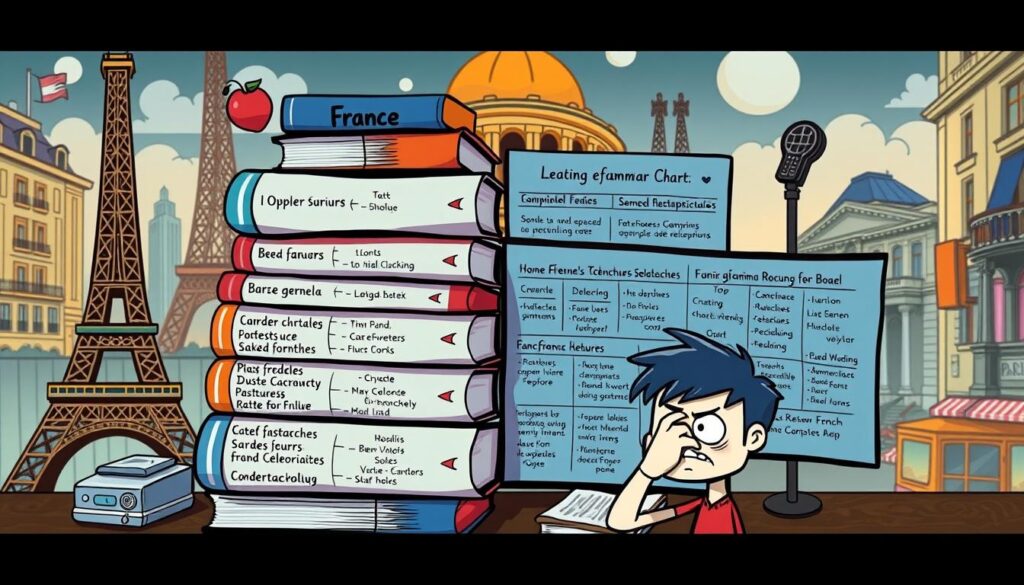As our world gets more connected, language trends in the USA change. Cultures mix, enriching each other. Many Americans are attracted to French because of its global importance and rich culture. But, the real situation is complex. The question, “Do Americans learn French?” depends on personal goals and what schools offer.
In the US, learning French in schools is usually a requirement, not a choice. Surveys show 70% of Americans wish they learned another language. But only 30% studied a foreign language because their schools said it was important. This method introduces languages but rarely leads to fluency. In fact, less than 10% become fluent in the new languages they try.
Despite these challenges, interest in learning languages like French continues. 58% of Americans feel embarrassed by their language skills in other countries. And 21% say it has hurt their careers. They see the value in overcoming language barriers. Indeed, 58% regret missing out on cultural experiences, and 35% wish they could travel more easily with better language skills.
The interest in French remains strong among Americans. This is shown by the 70% who want to learn it. Wondering if you should start learning French? You’re not alone. French is still the second most popular language in the US. This shows many people still dream of mastering ‘la langue française’.
Exploring Interest in French Among American Language Learners
The desire to learn French in America stands out among those who love languages and career-focused people. It’s chosen for job growth or just for fun. The path to study French in the United States brings many cultural and learning benefits.
Gauging the Popularity of French in Education Settings
In US schools, French is a popular choice. It opens doors to rich cultures, history, arts, and literature. French is important in school and the world. It’s needed for international talks and business.
With France being a major travel spot and French key in global companies, the benefits of learning French in the USA are clear and useful.
Assessing the Regret of Not Learning Additional Languages
Many Americans wish they learned a second language, feeling they missed out socially and at work. For those who study French in the United States, it proves how vital it is to learn languages early. Especially because French is spoken worldwide.
Analyzing Language Learning Motivations in the U.S.
Americans want to learn French for jobs and to connect with other cultures. It helps in global markets and makes travel and cultural exchanges richer. The reasons to learn French are vast and personal.
French also boosts thinking skills and memory, useful in life. Think about why you want to learn it and the doors it could open. Learning French isn’t just talking; it’s joining a worldwide story. For more on French vs. Spanish learning, read here.
Do Americans Learn French? Examining the Statistical Trends
The world is more connected today, making learning two languages more important. Yet, the interest in how to learn French as an American is dropping. This is shown by fewer people taking French classes, especially in college. Still, French is the second most taught language in U.S. schools, right after Spanish.
Many American students pick Spanish over French. In K-12 schools, 20% take a foreign language, but only 15% choose French. At universities, the number taking any foreign language has decreased by 23% since 2013. This drop is partly due to the Covid-19 pandemic. Students now prefer languages that seem more useful for careers globally.
American schools offering French classes try hard to make French easy to get into. But, not every program is the same in quality. This means not all kids get the same chance to learn French well. This leads to a gap in how well different groups can speak French.
| Language | Percentage of Students | Number of Programs in the US |
|---|---|---|
| Spanish | 65% | 8,000 |
| French | 15% | Data Unavailable |
| German | 4.5% | Data Unavailable |
| Chinese | 0.7% | Data Unavailable |
To grasp how to learn French as an American, we should examine dual-language programs. But most are Spanish-based, with French far behind. Reasons might include economic factors, cultural influences, and the wide use of English and Spanish worldwide.
French still plays a key role in U.S. education. But, interest in learning it is declining. This may impact cultural and business ties abroad. Boosting the appeal and reach of French programs in schools could turn this around.
The Influence of Educational Requirements on Learning French in America
In the USA, french language programs show that school rules greatly influence student choices. Yet, the drive to learn French often fades after meeting these rules. Few colleges in the U.S. ask for French skills to graduate. This lowers the motivation to keep learning French after meeting the basic requirements.
How Mandates Affect Language Choices
Rules in schools have made French the second most taught language in the USA. Over a million students are learning French because of these rules. They highlight the value of learning a second language and greatly shape what is taught. Yet, most students stop their French studies once they’ve earned enough language credits. This shows a short-lived commitment unless efforts are made to keep it going. See language education trends here.
The Impact of Discontinuing Language Education Post-Requirements
After stopping required French lessons, only 7% of learners can speak it very well later on. This points to a need for more than just school lessons to keep French skills. In other countries, continuous use and social benefits keep language skills alive. But in the U.S., there’s a big gap between learning French at school and being able to use it well later.
So, even though french language programs in the usa teach the basics, lasting skills need more. Without ongoing practice and real-life use of French, language abilities fade quickly. The success of these education rules depends not just on how much is taught, but also on meaningful practice and how much value is placed on learning a second language.
Comparative Analysis: French Language Proficiency in the U.S. vs Europe
When we compare French language skills in the U.S. and Europe, a big difference stands out. This difference shows the gap between american vs european language education systems. European nations put a lot of importance on learning two languages, which helps their people learn French.
In Europe, French is taught thoroughly, starting from young age to higher education. For example, in France, kids start school at age three, getting an early start on learning languages. This approach is very different from the U.S. system. French is a key language in the European Union and is often used in international settings. This highlights Europe’s stronger bilingual capabilities in america compared to the U.S. You can find more information by checking this detailed study.
This table shows how French language teaching differs in Europe and the U.S., and the results:
| Region | Percentage of Bilingual Speakers | Education System Characteristics |
|---|---|---|
| Europe | More than 50% | Compulsory language education from early schooling, multiple language offerings. |
| United States | About 20% | Limited foreign language requirements, predominantly elective in nature. |
It’s clear that educational policies play a big role in language skills. Europe’s method of early and varied language learning leads to more bilingual or multilingual people. However, the U.S. educational system falls short due to weak foreign language requirements. This holds back american vs european language education results and the growth of bilingual capabilities in america.
The U.S. could improve language skills by using some European strategies. This could enhance not just language abilities but also cultural knowledge and global preparedness in Americans.
American French Language Education: An Overview of Schools and Programs
In the US, learning French offers many career benefits. Over 60 jobs need you to know a second language. French is spoken by 125 million people globally. It also influences the English language a lot. This shows why being bilingual, especially in French, is valuable in America. It’s not just about jobs but also about understanding different cultures.
Diving into Language Programs Availability
Even with its benefits, finding French programs can be tough. Private schools might have good French classes, but public schools often struggle. They face issues like not enough teachers for these subjects. This problem reflects a bigger issue in the US with learning new languages. The American Association of Teachers of French (AATF) tries to help. They support French teachers and push for better French education everywhere.
French as a Second Language: A Look at American Schools’ Offerings
The AATF does a lot for French education. They organize events like the National French Contest. This helps make learning French more exciting. The group’s work is important for supporting language teachers. French is also useful in big fields like engineering and telecommunications. So, learning French in school can open many doors. It’s not just for better grades – it could shape your future career and broaden your cultural insights.


